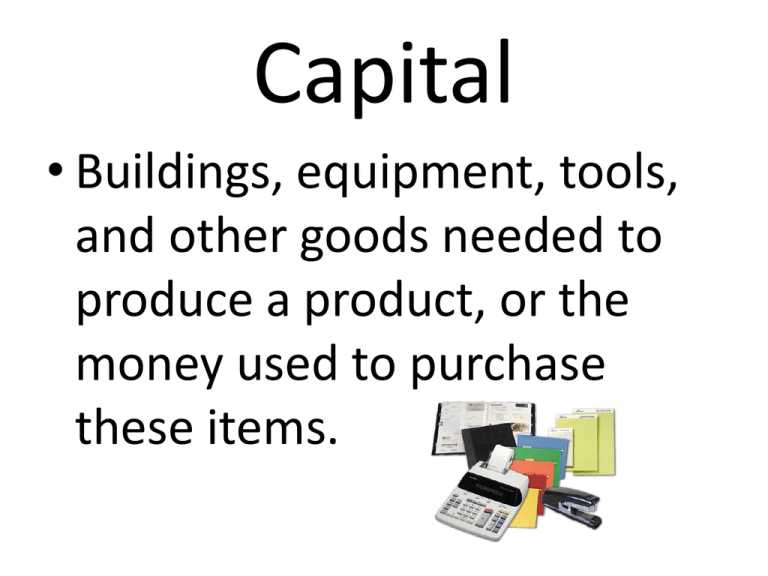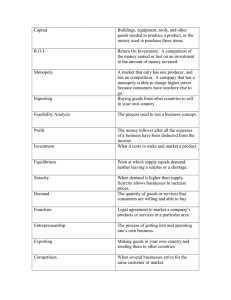Capital
advertisement

Capital • Buildings, equipment, tools, and other goods needed to produce a product, or the money used to purchase these items. R.O.I. • Return On Investment. A comparison of the money earned or lost on an investment to the amount of money invested. Monopoly • A market that only has one producer, and has no competition. A company that has a monopoly is able to charge higher prices because consumers have nowhere else to go. Importing •Buying goods from other countries to sell in your own country Feasibility Analysis •The process used to test a business concept Profit • The money leftover after all the expenses of a business have been deducted from the income. Investment •What it costs to make and market a product Equilibrium •Point at which supply equals demand, neither leaving a surplus or a shortage. Scarcity •When demand is higher than supply. Scarcity allows businesses to increase prices Demand •The quantity of goods or services that consumers are willing and able to buy Franchise •Legal agreement to market a company’s products or services in a particular area. Entrepreneurship The process of getting into and operating one’s own business. Exporting •Making goods in your own country and sending them to other countries Competition •When several businesses strive for the same customer or market. Consumer Product Safety Commission •Watchdog for consumers over products that may be hazardous. Equal Employment Opportunity Commission • Protects the rights of employees age, race, color or national origin, religion, gender or physical challenge. Fair Labors Standard Act • Minimum wage and maximum working hours are identified. Children under 16 cannot work fulltime except if employed by parents. Occupational Safety & Health Act •Ensures safe and healthy working conditions for employees. Fair Packaging and Labeling Act • Requires manufacturers truthfully label products, showing all raw materials used in the production process. Target Market •The specific market segment toward all of a business’s activities are directed. Demographics •Statistical data that describes a given market by criteria such as age, gender, and income. Psychographics • Statistical data that describes a given market by criteria such as personality, opinions, and lifestyle. Geographics •Study of the market based on where customers live by region, state, city, and/or area. Buying Characteristics • Customers will purchase products or services from companies they know or have experience with. Market Segmentation • Group of people whose opinions are studied to determine the opinions/buying preferences of a larger population Competitive Analysis •Process of grouping a market into smaller groups defined by specific characteristics. Market Research •Business that offers similar products as your business Mission Statement •Expresses specific goals for the company. Channels of Distribution • The path a product takes from producer to final user (consumer.) Includes transportation, storage & product handling Organizational Chart •A graphic representation of the company’s organizational structure. Marketing Mix •The 4 P’s. Product, Price, Place, Promotion Partnership • A business with two or more owners who share ideas, abilities, or financial obligations. Partners do not have to share equally. Credit •Allows customers to obtain products or services with the promise to pay later. Corporation • This legal form of ownership operates apart from its owners, and lives-on after the owner dies. Registered by the state and operated apart from its owners. Ownership represented by shares of stock – public or private. Promotional Mix •Includes advertising, publicity, personal selling, and sales promotions. Price Lining •Pricing strategy that is used to offer products in the same line at several different prices; low, medium & high. Promotional Pricing •Pricing method that lowers prices for a limited time to stimulate demand. Perpetual Inventory •Inventory system that us updated on a daily basis. Quantity Discounts • Pricing method that is often used when ordering t-shirts for the school – the larger the order, the cheaper the per-unit price. Income Statement • Summary of a company’s profit or loss during any one given period of time Also known as a Profit & Loss Statement. Start-up Costs •The one-time expenses paid to establish a business. COGS •Cost of Goods Sold – the cost of inventory to be sold in a business Net Income •Gross income minus operating expenses. Break-Even Point •The volume of sales that must be made to cover all expenses of the business Equity Capital •Cash invested in a business in exchange for an ownership stake in the business. Collateral •Security in the form of assets you pledge to a lender. Fixed Expenses •Lease payment, salaries, insurance, advertising. Expenses that do not change with the number of units sold. Variable Expenses •Expenses that do change with the number of units sold or produced. Gross Income •Total income minus COGS sold. Focus Group • A group of people whose opinions are studied to determine the opinions/buying preferences of a larger population. Capacity •Your ability to repay a loan based on incoming and outgoing cash flow. Code of Ethics •Behavior guidelines that describes appropriate conduct for a business or organization. Global Company • A business that sells products in more than one country Domestic Company •A business that sells product in its own country Web-based business • A business that generates their revenue directly from their website. Primary Data • Research collected for the first time and relates directly to the collector’s study. Secondary Data • Information collected by someone else for their own purpose. Five Steps of Market Research • • • • • Identify Your Information Needs Obtain Secondary Resources Collect Primary Data Organize the Data Analyze the Data Niche •A small, specialized segment of the market based on customer’s needs. Direct Competitors •Offer similar products Indirect Competitors • Offer close substitutes that meet the same basic need. Industrial Markets •Group of customers who buy products or services for business to use; (not consumer-based) Location •Critical factor in the success of a business, especially for retail stores. Sole Proprietorship • Owned and operated by one person. Easy to create. Owner receives all profits, incurs any losses, and is liable for the debts of the business Advertising • Paid non-personal presentation of ideas directed toward a mass audience. Publicity •Free placement of newsworthy items about company, etc. in the media. Personal Selling •Giving an oral presentation to one or more potential buyers. Promotions •Use of incentives or interest-building activities to create demand. Competition-Based Pricing •Lower or raise of products/services based on what the competition is doing. Odd/Even Pricing •Odd numbers suggest bargains ($19.99). Even numbers suggest higher quality ($20.00) Assets • Represent things of value that person or company owns and has in its possession. Liabilities • What a person or company owes to others—creditors, suppliers, tax authorities, employees, etc.. They are obligations that must be paid under certain conditions and time frames. Equity •Ownership in a business. The 5 C’s of Credit to Qualify for a Loan • Character • Capacity • Capital • Collateral • Conditions




